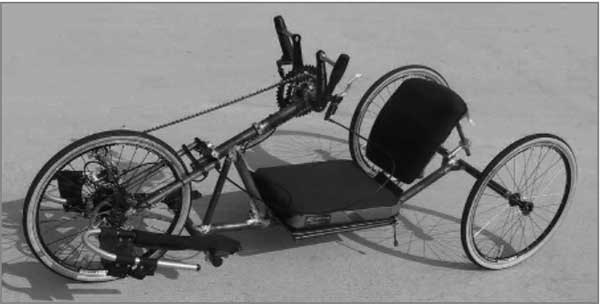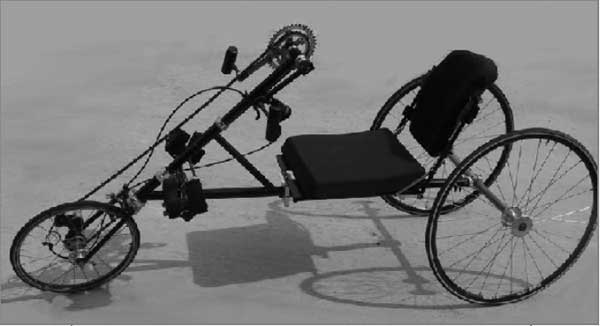HAND CYCLE: A DESIGN EVALUATION
ABSTRACT
The "Generation 2" hand cycle (fig 1) was designed primarily for racing and long distance cycling on smooth roads. Goals for the design were to reduce rider fatigue on long rides, increase comfort while riding, increase arm crank efficiency and create a compact transportable design. The design criteria are based on evaluations of currently available hand cycles as well as a previous prototype "Generation 1" (fig 2) hand cycle. Additionally, the "Generation 2" hand cycle served as a test platform for design concepts that may be incorporated into future hand cycle designs.
 |
BACKGROUND
Hand cycling is a popular sport among people with lower limb impairments. It is popular in part because participants can exercise alongside bicyclists, making it an excellent family/ social activity. Hand cycles have been used for therapy and as transportation for decades. In recent years they have evolved into high performance recreation equipment.
 |
Arm Crank Exercise (ACE) has emerged as a possible solution to improving cardiovascular fitness, with research showing that ACE is more efficient and less of a physical strain than conventional wheelchair propulsion. Studies have shown that reduced physical strain, increased endurance time and higher velocities are possible when using a hand cycle over a traditional wheelchair for mobility (1). Others have shown that individuals using hand- cycles during racing achieved higher peak power outputs than counterparts using traditional wheelchairs (2). Therefore, hand- cycles may be useful in propelling long distances and may encourage individuals with lower extremity impairments to exercise, improving fitness, rehab outcomes and function in the activities of daily living, and reducing risk for secondary disability. Cooper showed that wheelchair racing, even recreationally, helped improve self-esteem and reintegration into society (3).
Hand cycles come in primarily two styles, recumbent and upright. The upright configuration has a higher seat, improving transfers, but its higher center of gravity creates instability at higher speeds and around curves. Recumbent style cycles are better for users who want to cycle at higher speeds (up to 30 mph), increase their aerodynamics and who ride mostly on tracks or long wide roads versus narrow paths and through a city where a tight turning radius matters more.
STATEMENT OF THE PROBLEM
The "Generation 2" hand-cycle was designed primarily for racing and long distance cycling on smooth roads or a track. Goals for the design were to reduce rider fatigue on long rides, increase comfort while riding, increase arm crank efficiency and create a compact transportable design.
RATIONALE
The first step in developing design criteria for the hand-cycle was to identify the needs of the user and the environment of use. The next step was to evaluate existing hand-cycle designs including those in the consumer market as well as the "Generation 1" hand cycle, which addressed some of the same design problems as the "Generation 2."
The user needs as determined through conversation with the user are; reduced fatigue on long rides, better trailing on crowned roads, comfort while riding and efficient arm cranking. The hand cycle's primary use is racing and long distance cycling on smooth roads or a track. It is transported in a minivan.
Through user reviews and test rides of various hand cycles, we determined common problems with designs available on the market; minimal adjustability, poor trailing, poor aerodynamics, cables that get in the way of pedaling, minimal shock absorption, non-compatible components, geometries and gear ratios which make it difficult to pedal uphill, difficult transfers, heavy and bulky to transport, and footrests which drag on the ground when making sharp turns.
The "Generation One" hand cycle attempted to solve some of the problems found with current designs. It is semi-recumbent (12 inch ground clearance) and thus easier to transfer into than a recumbent (6 inch ground clearance) and more stable than an upright. The frame is made of small diameter (1.25 inch) Chrome-Moly tubing allowing the frame to flex and absorb road vibration. The brake and shifter are mounted to the frame, keeping cables from getting in the way of arm cranks. On the other hand, "Generation One's" higher center of gravity made it less stable than low riding cycles. Because of the brake placement the user needs to remove their hand from the handles in order to squeeze the brake, which is awkward. The gear ratio is not low enough to efficiently climb hills. Legs must be strapped onto the foot- rests and large rear tires (24 inches) made the cycle cumbersome to transport.
DESIGN
The design criteria for "Generation Two" are based on evaluations of currently available hand cycles, the previous prototype "Generation 1" hand cycle and the user needs. They describe the standards or constraints by which the cycle was designed; efficient use of materials for light weight and compactness, durability, shock absorption, ergonomically good position for arm cranking, adjustability for comfort and efficient pedaling, simple construction and OEM bicycle parts used whenever possible
Design features of the hand cycle are; a low center of gravity for stability at high speeds, long wheel-base for good trailing, disk brake for high speed braking, wide gear range, ergonomic handles, semi-recumbent body position, foot rests which don't drag on the ground when turning, 1.25" thin walled Chrome-Moly tubing for shock absorption, strength and light weight, Polyurethane cushions between the between the seat frame and main frame for shock absorption where it is needed most, Jay seat back, bicycle components, 27 gears and 20 inch wheels.
DEVELOPMENT
All the non- OEM parts were made in the HERL machine shop using CAD/CAM software and machining and manual machining. The frame was brazed together in an aluminum jig. All aluminum components will be anodized. All steel components will be powder coated.
EVALUATION
"Generation Two" is lightweight. Frame flexibility and Polyurethane shock absorbers absorb road vibration. Low center of gravity (6 inch ground clearance) stabilizes the frame in curves and at high speeds (~25 mph). Seat back adjustability, adjustable foot rests and ergonomic handles increase comfort and fit. Increased gear range (27 gears) makes climbing hills easier. Small wheels and light weight make it easy to transport.
Certain design features did not provide the optimal fit and function. The following evaluation may be considered for modifications to the hand-cycle or for the development of a "Generation Three" hand-cycle. The adjustability in the steering column does not provide the ideal arm cranking position. It is functional but feels a little cramped. The seat bottom adjustability would better serve its function if the arm crank position were improved. The long wheelbase improves trail compared to "Generation One" but resulted in a small steering column to ground angle that makes steering difficult. The problem was remedied by adding a spring as a steering compensator. This geometry problem could be solved in different ways while preserving the long wheelbase. Many components such as the seat frame could be built using composite materials or plastics to lighten the weight. The rear axle release clamp used in "Generation One" could be incorporated into the next design for easier transportability. Adjustable camber would further increase stability at high speeds. A fairing could be added for aerodynamics and to protect the user from road debris. A chain ring cover should be added for safety.
DISCUSSION
The "Generation Two" hand cycle served as a test platform for design concepts that may be incorporated into future hand-cycle design projects at HERL. One such project is the "Growable hand cycle," a cycle for children with disabilities which would incorporate adjustable features from the "Generation Two" allowing the cycle to be adjusted as the child grows.
-
Cooper RA. (1990) Wheelchair Racing Sports Science: A Review. J Rehabil Res Dev. 27(4): 295-312.
ACKNOWLEDGMENTS
This project was funded by the VA Rehab R&D center
Emily
Zipfel
7180 Highland Drive
Pittsburgh PA 15206
412-365-4947, ezipfel@pitt.edu
